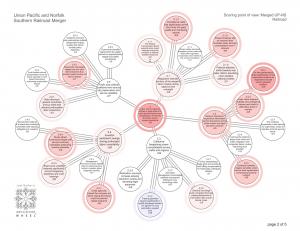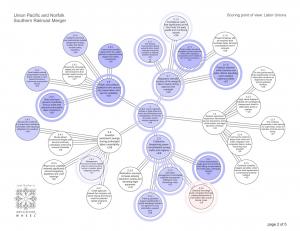Strategic Analysis of the Potential Union Pacific–Norfolk Southern Merger
Custom AI tools provide analysis of the proposed transportation merger with advanced insights.
The Implications Wheel will give you a substantial advantage in finding, recognizing, and securing your future.”
MILWAUKEE, WI, UNITED STATES, August 26, 2025 /EINPresswire.com/ -- A strategic exploration of the proposed merger between Union Pacific (UP) and Norfolk Southern (NS) was conducted based on futurist Joel Barker’s Strategic Exploration Tools. If approved, the merger would create the first coast-to-coast freight rail system in U.S. history, fundamentally reshaping the nation’s transportation landscape.— Joel Barker
The latest in a series of reports that have explored human resource trends, e.g., A.I. Superworkers, and critical issues, e.g., Veteran Suicide and Youth Online Gambling. The analysis was “highly facilitated,” using custom GTPs trained on Barker’s techniques.
“This is strategic thinking at the frontier,” said Jim Schreier, author of this report, and personally trained by Joel Barker, futurist and creator of the Implications Wheel®. Before his passing in January of 2025, Barker commented: “We’ve spent decades using human diversity to understand the future. Now, with ChatGPT, we can add global breadth, speed, and perspective—a ‘the Wisdom of the World’ approach. The overlap between AI-generated arcs and those produced by trained facilitators is astonishing.”
The exploration employed a Strategic Alternatives Analysis combined with the Implications Wheel methodology to evaluate the possible consequences, risks, and opportunities associated with the possible merger.
Strategic Alternatives Analysis: Three Futures
The first part, Strategic Scouting Journey, of the analysis centered on three strategic alternatives, identified as Best Case, Base Case, and Worst Case futures. Implications were mapped for different stakeholder groups.
• Best Case – “Green Light Megarail”
Regulators approve the merger with limited conditions. A unified UP–NS system integrates operations quickly, creating a seamless coast-to-coast freight corridor. Large shippers benefit from faster, more reliable service, ports see increased throughput, and investors enjoy strong returns. Rail regains market share from trucking, with environmental gains from reduced highway congestion and emissions.
• Base Case – “Slow Roll Integration”
The Surface Transportation Board (STB) grants approval after a lengthy review but imposes significant conditions, such as mandated track-sharing agreements, rate oversight, and labor protections. Integration is slowed by compliance obligations and stakeholder disputes. Efficiency gains are partially realized, but smaller shippers see little relief, and unions press for job guarantees.
• Worst Case – “Derailment”
Regulators block the merger outright, citing competition concerns. The rail industry remains divided between East and West operators, losing the chance to unlock coast-to-coast efficiencies. Trucking retains its dominance in long-haul freight, and UP and NS face investor pressure to pursue alternative strategies.
The Implications Wheel: Scoring Future Impacts
The second part, a "12 - 2 - 60 Scouting Journey, used the principles of futurist Joel Barker’s Implications Wheel, a structured foresight tool, to map first-, second, and third-order consequences of the possible merger. Initially, twenty-four "first-order" implications were generated. Then selected “arcs” were explored for second- and third-orders, and then scored for both desirability (positive or negative impact) and likelihood from two different points of view: 1) Proposed Merged Railroads, and 2) Labor Unions.
Key Implications Identified and Scored:
1. Efficiency vs. Rates
o First-order impact: Large shippers gain from faster coast-to-coast transit.
o Second-order impact: Smaller shippers risk higher costs if reduced competition limits negotiating power.
o Score: High likelihood, mixed desirability (positive for large shippers, negative for smaller ones).
2. Labor Market Transformation
o First-order impact: Consolidation threatens some jobs through operational overlap.
o Second-order impact: Potential redeployment into new technology-enabled rail operations if investment is strong.
o Score: Moderate likelihood, high negative impact if job loss outweighs retraining.
3. Environmental Opportunity
o First-order impact: Rail gains share from trucking, cutting emissions.
o Second-order impact: Long-term sustainability branding improves rail’s public and political standing.
o Score: High likelihood, high desirability if policy incentives align.
By scoring these and related implications, risks that could be mitigated, such as labor protections and rate transparency, and opportunities that could be amplified, such as environmental positioning and technology investment were identified. Two sample "arcs" included here illustrate the differences among implications when they are viewed from different points of view. The report includes "Comparison Scoring" graphics for five sample "arcs."
T.I.P.S. Interrogation
The T.I.P.S. Tracking Framework was also applied as a background analysis to situate the merger in its broader industry context.
• Trends: Rail consolidation is accelerating, with the 2023 Canadian Pacific–Kansas City Southern merger serving as precedent.
• Innovations: The UP–NS deal is a business model innovation, integrating networks across the continent for the first time.
• Paradigm Shifts: The merger would replace the century-old East/West split in U.S. freight rail with a unified national system.
Strategic Insight Contributions
Throughout the process, strategic insight suggestions were generated by the custom GPTs:
• A stakeholder map identifying supporters (rail executives, large shippers), opponents (labor unions, small shippers, competitor railroads), and swing influencers (STB, Congress, port authorities).
• Probability-weighted scenarios based on recent precedent and regulatory behavior.
• Identification of lobbying positions and public messaging strategies likely to shape the approval process.
These inputs enriched deliberations and ensured the coalition’s evaluation addressed both immediate impacts and long-term strategic positioning.
A Model for Future Analysis
This integration of artificial intelligence with strategic foresight tools opens a new chapter in planning, policymaking, and innovation. It demonstrates that by combining the creativity and compassion of human facilitators with the speed and scope of AI, society can develop more thoughtful and adaptive responses to complex, emotionally charged issues.
“This merger has the potential to transform American freight logistics in profound ways,” said Jim Schreier, the facilitator for the exploration. By definition, Joel Barker’s tools are “decision-enhancing information for leadership.” The goal is not to take a side, but to ensure that the decision—whether for or against—is made with a clear-eyed understanding of its ripple effects across industries, communities, and the country as a whole.”
The “Rail Merger – Strategic Journey” and Rail Merger: 12-2-60” reports are available now as downloads.
Download links/QR Codes: Strategic Scouting Reports
Website: ImplicationsWheel.org
James Schreier
Strategic Exploration Consultant
+1 414-828-0856
jim.schreier@strategicexploration.com
Visit us on social media:
LinkedIn
Legal Disclaimer:
EIN Presswire provides this news content "as is" without warranty of any kind. We do not accept any responsibility or liability for the accuracy, content, images, videos, licenses, completeness, legality, or reliability of the information contained in this article. If you have any complaints or copyright issues related to this article, kindly contact the author above.



